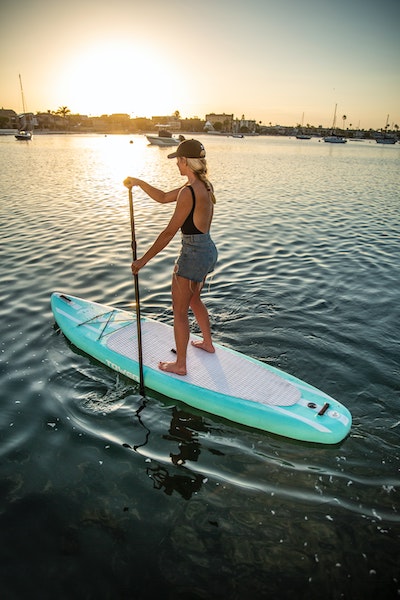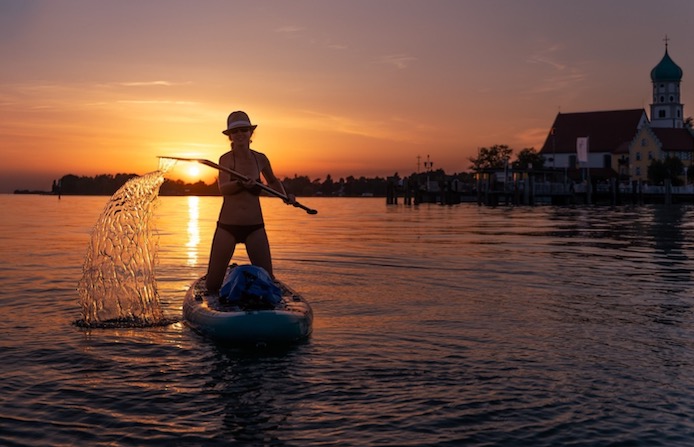Learning to Paddle Board
Learning to paddle board won’t be as difficult as you think if you are new to it.
In the first guide, we talked about what to bring to your ultimate SUP trip. Here, we’ll actually discuss how to learn it.
Before we get to the finer details, the first real lesson is what is SUP?

SUP or Stand Up Paddle Boarding is an outdoor recreation or water sport where people stand up on a board and use a paddle to get around. I think it’s more than self-explanatory.
But SUP can be so much more than that! Stand Up Paddle Boarding can be exercise, somewhere to do yoga and meditation, a form of transportation, and a fun way to enjoy bodies of water and scenery. If you’ve come here, I’m sure you are more than curious to try it out yourself. So, let’s get to the basics.
Is Paddle Boarding Difficult to Learn?
Learning to paddle board is actually easier than many other water sports and so it available for people of all ages. Compared to surfing, this is quite a low-intensity sport.
Beginners can opt to use different techniques to help them get more comfortable standing on the board and paddling. You actually don’t even need to be on the board the whole time! Some sit or kneel on the board to steady themselves or take a break.
As a low-intensity sport, the barrier to learn is low and you can become an expert in no time! If you have the proper tools and training, it would be easy to get started and build your foundation.
Once you have the right techniques, the options for SUP are limitless! You can go on a paddling race, do SUP yoga, go whitewater paddling, go rapids paddling, and much much more!
So, with calm waters and a basic board, you can start easily! Check out this excellent video that takes you step-by-step through learning to paddle board, from setting your oar correctly to paddling techniques.
The Basics: How to Get Geared Up and Standing on a Board
While it’s best to learn to paddle board from an expert or other trained instructors, you can figure out the basics on your own. The first step is to get geared up. Make sure to read the first guide to know what you should bring for your adventures!
Once you have complete gear, the first challenge is to stand on the board. With some people struggling with their balance, this is not always the easiest step. So, we take it back a little and start with kneeling on the board.
Simple take your board and lay it on calm waters with the deck up and the fin down in the water. Strap on the leash to your ankle and wade further into the water until it’s about knee-deep. Once there, hoist one of your knees on the board and follow with the other.
There! Congratulations! You are already paddle boarding. From this position, you can opt to use your paddle to stir yourself in different directions and get a feel for the water, being on the board, and the sport itself. We recommend starting with kneeling because your center of gravity is much more stable when you’re nearer to the ground; or in this case, water.
From there, you can try to move one of your feet back and stand up. This takes more practice for some people though! So, don’t get discouraged and just keep trying. Make sure you’re wearing your protective gear so that you can stay safe even if you fall.
Check out this useful video on learning to paddle board which focuses specifically on standing up for the first time on your board.
So now let’s look at some of the key tips and tricks of paddle boarding to get you on your way successfully.
Tips & Tricks of Learning to Paddle Board
1. Choose the Right Gear
Having the right size and right type of equipment is absolutely essential. For beginners, an inflatable all-round board should do the trick!
2. Start with flat water. Don’t learn on rapids or unpredictable seas.
These are some of the few cases you can easily bite off more than you can chew. So, remember to pace yourself and make safety your number one priority.
We recommend you learn on calm flat water especially for your first few paddle boarding sessions. Slow moving rivers or lakes are best for this, but if you are on the sea, stay near the shore or do it with other people also to keep safe! The sea can be dangerous if you are caught out with tides, even for more experienced paddle boarders.
3. Practice makes perfect. Try and try.
Like any other skill, you’ll need some trials to get the hang of it. So, just keep trying! Eventually, your body will learn how to balance and you can be paddling for days.

4. Just have fun!
When all else fails, enjoy the view. If that means sitting or kneeling on your board or just sitting by the shore after a few tries, remember that this is for fun!
So, don’t be afraid and try it for yourself. It’s even a lot easier than learning how to ride a bike! After a few times of trying, you’ll get to expert status and you can explore so much more the sport has to offer! SUP up!
Leave a Reply